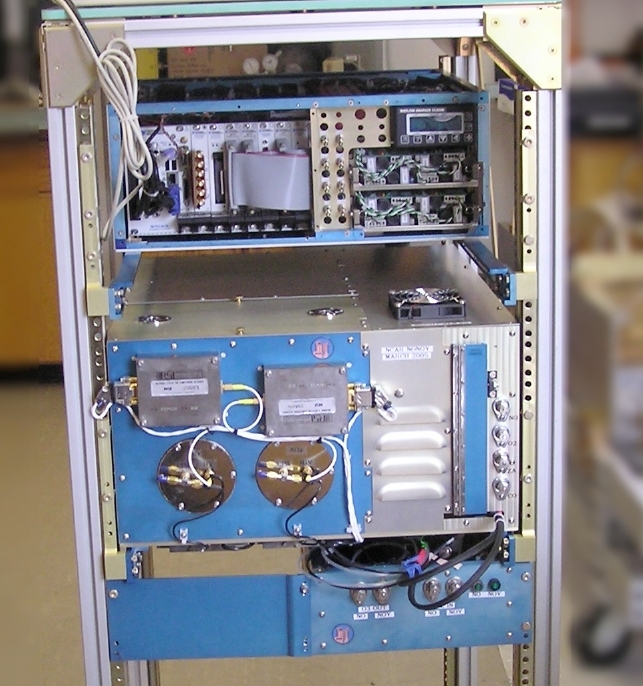

Principal Investigator: Andrew J. Weinheimer (wein@ucar.edu)
Co-Investigators: David J. Knapp (david@ucar.edu, Denise D. Montzka (montzka@ucar.edu)
This is a 2-channel instrument based on the chemiluminescence detection of NO via reaction with O3 to form excited NO2, which is detected via photon counting. One sample channel is used to measure NO, and the second measures total reactive nitrogen, NOy, by flowing ambient air through a gold-tube catalyst for the reduction of oxidized species to NO via reaction with CO. Reactive nitrogen is emitted into the atmosphere in the form of NO, then oxidation processes result in conversion to other reactive nitrogen, or NOy, species: NOy = NO + NO2 + PANs + HONO + HNO3 + HO2NO2 + NO3 + 2N2O5 other organic nitrates + particulate nitrate, etc. The instrument is similar to instruments previously built at NCAR [Ridley and Grahek, 1990; Ridley et al., 2004].
In the UTLS region, NOx (=NO + NO2) is mostly in the form of NO and is formed in situ by lightning and may be transported to the UTLS from the boundary layer by convection. NOy is a very useful tracer throughout the troposphere and especially across and above the tropopause. In the lower stratosphere O3 and NOy exhibit compact positive correlations that depend on latitude and season. Perturbations to the usual relationship can provide key information on tropospheric to stratospheric transport processes. In the troposphere, NOy is good marker for identifying reasonably rapid (hours to several days) convective or frontal system transport of surface emissions to the middle and upper troposphere.
The instrument (Figure 1) is centered around a 2-channel detector box which includes the reaction vessels (2), zero volumes (2), and photomultiplier tubes (2) for simultaneous detection of two sample flows, together with a number of flow controllers (for calibration flows, CO and O3 reagent flows, zero-air flows) and pressure transducers. A second box houses the computer for data acquisition and instrument control, together with power supplies, and a third box houses two ozonizers which produce O3 for reaction with NO to enable detection via production of excited NO2. Additionally, there is a vacuum pump, four gas bottles (zero air, O2 for O3 generation, NO-in-N2 calibration gas, and CO), and inlet components (catalytic converter for NOy, two sample flow controllers, valves for calibration gas addition). Dry ice is required for PMT cooling.

Figure 1. The upper box is the data acquisition and control system, including power supplies. The middle box is the main instrument module with 2 channels of detection, and the lowest box houses two ozonizers.
The instrument has yet to fly on the GV. It can fly as a stand-along instrument, but for START08, there will be a significant sharing of components with the HAIS O3 instrument and the RAF CO instrument. This will result in considerable weight and space savings for the overall payload. The items to be shared include these: data acquisition and control system, power distribution and power supplies, vacuum pump, pressure-control valve, zero air bottle, and inlet. The entire installation will occupy two racks plus some floor space. One rack is devoted to NO-NOy, and another rack is devoted to O3 and CO, along with the majority of the shared components.
Data will be recorded at 5 Hz, though the true frequency response is likely not that fast, and data will be archived at 1 Hz. The precision of 1-s values is estimated to be in the range of 5-10 pptv, dependent on performance characteristics to be determined in flight. Overall uncertainty of 1-sec values is estimated to be 10% or better for large mixing ratios (> 50 pptv). Further characterization of measurement error will be determined after acquisition of first data.
Ridley, B.A.; Grahek, F.E. (1990), A small, low flow, high-sensitivity reaction vessel for NO chemiluminescence detectors, J. Atmos. Oceanic Technol, 7, 307-311.
Ridley, B., L. Ott, K. Pickering, L. Emmons, D. Montzka, A. Weinheimer, D. Knapp, F. Grahek, L. Li, G. Heymsfield, M. McGill, P. Kucera, M. J. Mahoney, D. Baumgardner, M. Schultz, G. Brasseur, Florida thunderstorms: A faucet of reactive nitrogen to the upper troposphere, J. Geophys. Res., 109, D17305, doi: 10.1029/2004JD004769, 2004.